ME7725-B: Green Engineering Report on Biomass & Biofuel
VerifiedAdded on 2022/08/24
|11
|2631
|15
Report
AI Summary
This report provides a comprehensive analysis of green engineering principles, focusing on biomass and biofuel technologies and their contribution to carbon reduction and global warming targets. It critically assesses two national initiatives: The Renewable Heat Incentive (RHI) in the UK and the Renewable Fuel Standard (RFS) in the US. The report begins with an introduction outlining the significance of improving energy efficiency and transitioning to alternative energy sources, followed by a literature review that examines the EU's climate targets under the Paris Agreement and the relevance of RHI/RFS in achieving these goals. The report then delves into the methodologies and financial resources of each initiative, their intent, and the targeted sectors. It also addresses the inherent issues and limitations associated with biofuels and biomass use, such as impacts on food security and land use changes, and examines the remedial measures in place. The research methodology employed is deductive, utilizing existing research to develop and test hypotheses. The results and discussions section details the processes, requirements, and challenges associated with both RHI and RFS, comparing their merits and demerits to determine the best option for adoption. The report concludes with a comparison of the two initiatives, suggesting that the RHI model appears more realistic than RFS, and provides insights into their overall effectiveness in promoting environmental sustainability.
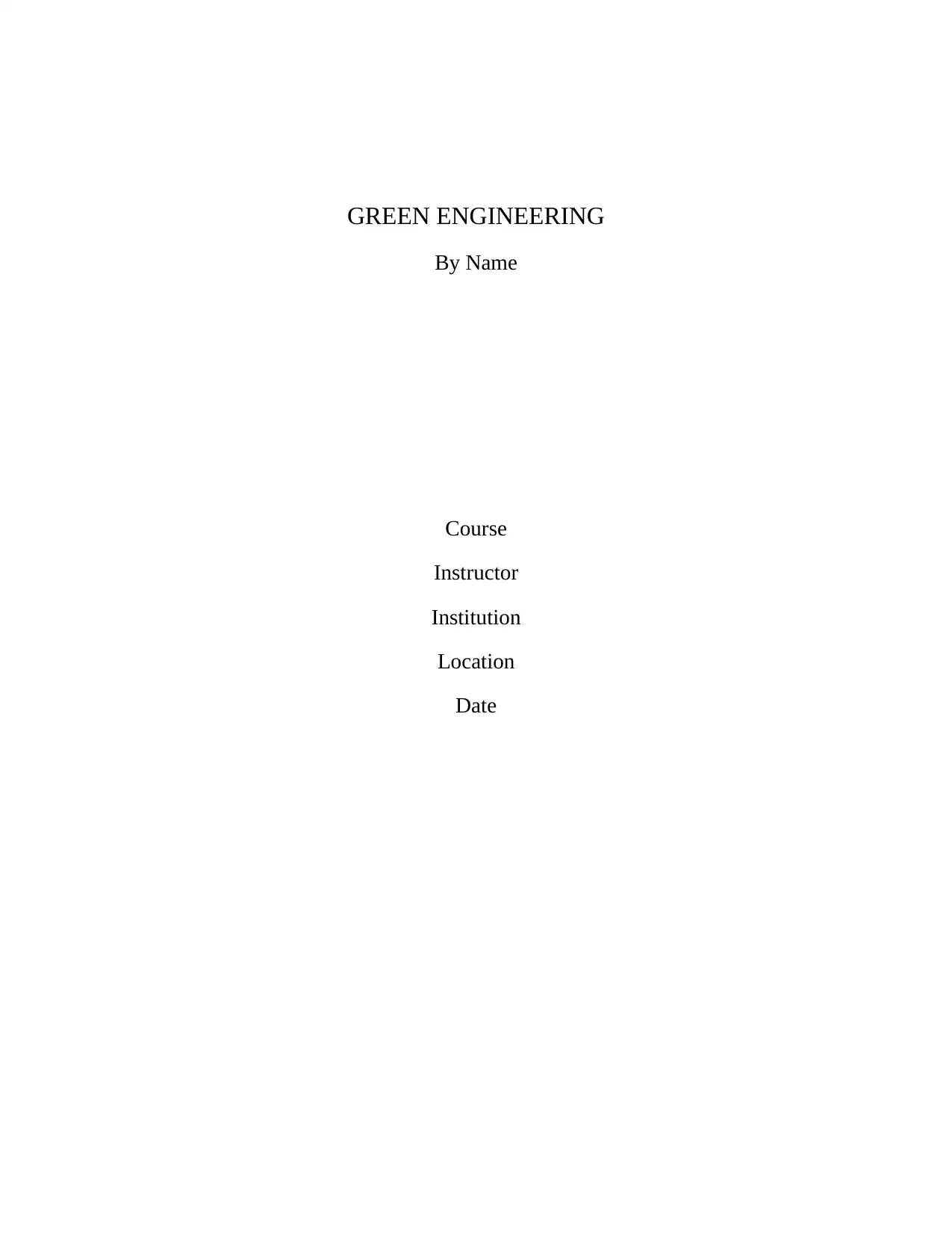
GREEN ENGINEERING
By Name
Course
Instructor
Institution
Location
Date
By Name
Course
Instructor
Institution
Location
Date
Paraphrase This Document
Need a fresh take? Get an instant paraphrase of this document with our AI Paraphraser
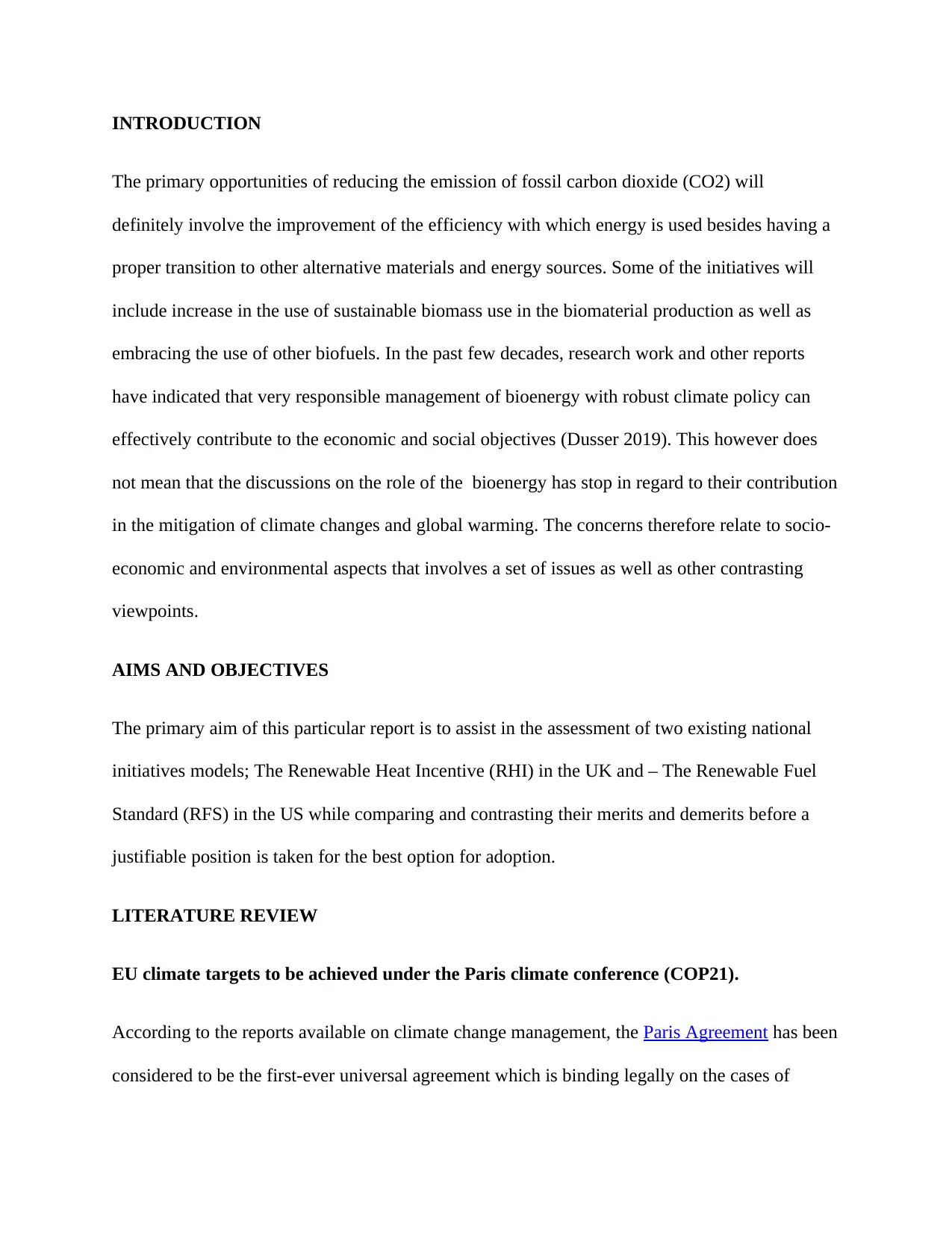
INTRODUCTION
The primary opportunities of reducing the emission of fossil carbon dioxide (CO2) will
definitely involve the improvement of the efficiency with which energy is used besides having a
proper transition to other alternative materials and energy sources. Some of the initiatives will
include increase in the use of sustainable biomass use in the biomaterial production as well as
embracing the use of other biofuels. In the past few decades, research work and other reports
have indicated that very responsible management of bioenergy with robust climate policy can
effectively contribute to the economic and social objectives (Dusser 2019). This however does
not mean that the discussions on the role of the bioenergy has stop in regard to their contribution
in the mitigation of climate changes and global warming. The concerns therefore relate to socio-
economic and environmental aspects that involves a set of issues as well as other contrasting
viewpoints.
AIMS AND OBJECTIVES
The primary aim of this particular report is to assist in the assessment of two existing national
initiatives models; The Renewable Heat Incentive (RHI) in the UK and – The Renewable Fuel
Standard (RFS) in the US while comparing and contrasting their merits and demerits before a
justifiable position is taken for the best option for adoption.
LITERATURE REVIEW
EU climate targets to be achieved under the Paris climate conference (COP21).
According to the reports available on climate change management, the Paris Agreement has been
considered to be the first-ever universal agreement which is binding legally on the cases of
The primary opportunities of reducing the emission of fossil carbon dioxide (CO2) will
definitely involve the improvement of the efficiency with which energy is used besides having a
proper transition to other alternative materials and energy sources. Some of the initiatives will
include increase in the use of sustainable biomass use in the biomaterial production as well as
embracing the use of other biofuels. In the past few decades, research work and other reports
have indicated that very responsible management of bioenergy with robust climate policy can
effectively contribute to the economic and social objectives (Dusser 2019). This however does
not mean that the discussions on the role of the bioenergy has stop in regard to their contribution
in the mitigation of climate changes and global warming. The concerns therefore relate to socio-
economic and environmental aspects that involves a set of issues as well as other contrasting
viewpoints.
AIMS AND OBJECTIVES
The primary aim of this particular report is to assist in the assessment of two existing national
initiatives models; The Renewable Heat Incentive (RHI) in the UK and – The Renewable Fuel
Standard (RFS) in the US while comparing and contrasting their merits and demerits before a
justifiable position is taken for the best option for adoption.
LITERATURE REVIEW
EU climate targets to be achieved under the Paris climate conference (COP21).
According to the reports available on climate change management, the Paris Agreement has been
considered to be the first-ever universal agreement which is binding legally on the cases of
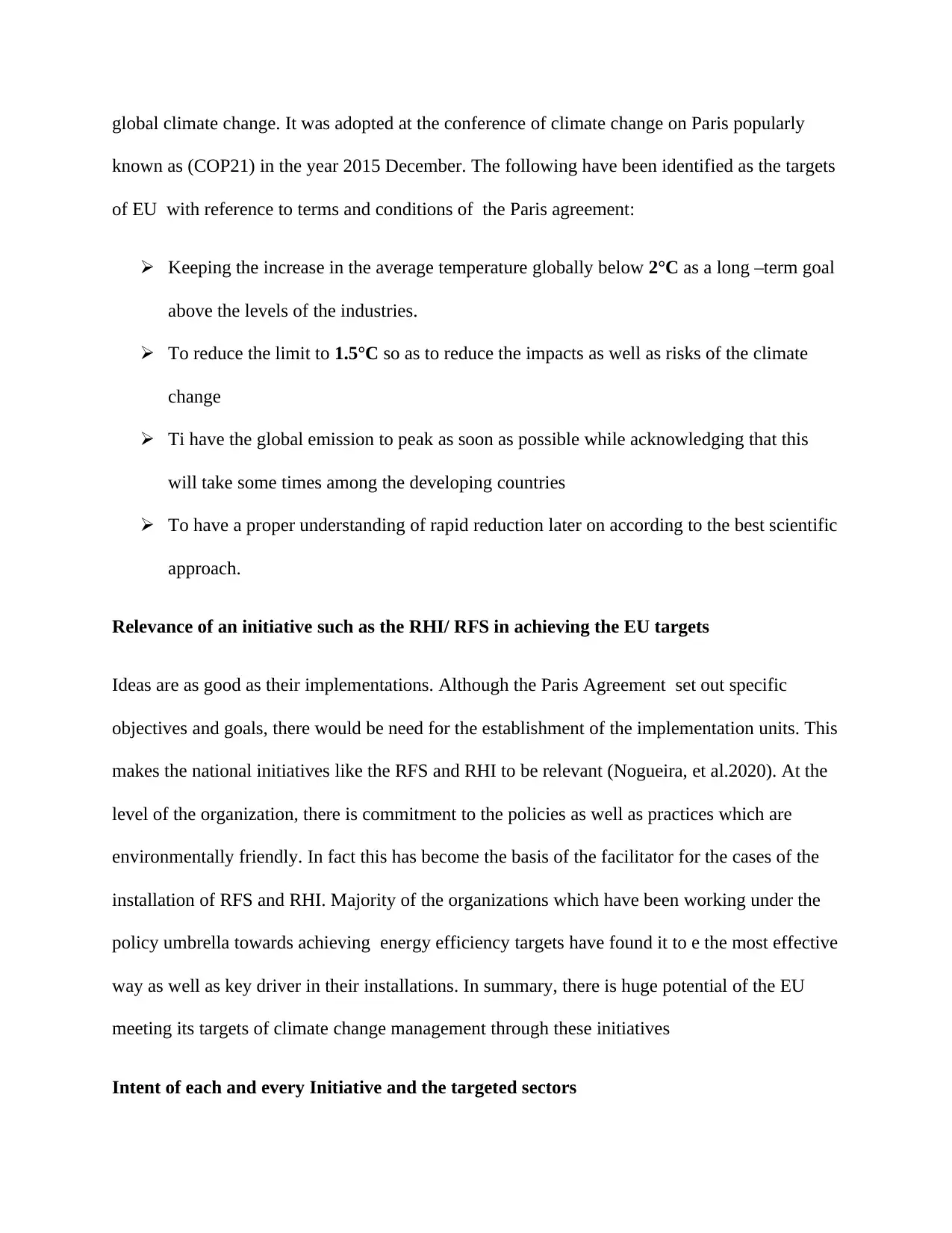
global climate change. It was adopted at the conference of climate change on Paris popularly
known as (COP21) in the year 2015 December. The following have been identified as the targets
of EU with reference to terms and conditions of the Paris agreement:
Keeping the increase in the average temperature globally below 2°C as a long –term goal
above the levels of the industries.
To reduce the limit to 1.5°C so as to reduce the impacts as well as risks of the climate
change
Ti have the global emission to peak as soon as possible while acknowledging that this
will take some times among the developing countries
To have a proper understanding of rapid reduction later on according to the best scientific
approach.
Relevance of an initiative such as the RHI/ RFS in achieving the EU targets
Ideas are as good as their implementations. Although the Paris Agreement set out specific
objectives and goals, there would be need for the establishment of the implementation units. This
makes the national initiatives like the RFS and RHI to be relevant (Nogueira, et al.2020). At the
level of the organization, there is commitment to the policies as well as practices which are
environmentally friendly. In fact this has become the basis of the facilitator for the cases of the
installation of RFS and RHI. Majority of the organizations which have been working under the
policy umbrella towards achieving energy efficiency targets have found it to e the most effective
way as well as key driver in their installations. In summary, there is huge potential of the EU
meeting its targets of climate change management through these initiatives
Intent of each and every Initiative and the targeted sectors
known as (COP21) in the year 2015 December. The following have been identified as the targets
of EU with reference to terms and conditions of the Paris agreement:
Keeping the increase in the average temperature globally below 2°C as a long –term goal
above the levels of the industries.
To reduce the limit to 1.5°C so as to reduce the impacts as well as risks of the climate
change
Ti have the global emission to peak as soon as possible while acknowledging that this
will take some times among the developing countries
To have a proper understanding of rapid reduction later on according to the best scientific
approach.
Relevance of an initiative such as the RHI/ RFS in achieving the EU targets
Ideas are as good as their implementations. Although the Paris Agreement set out specific
objectives and goals, there would be need for the establishment of the implementation units. This
makes the national initiatives like the RFS and RHI to be relevant (Nogueira, et al.2020). At the
level of the organization, there is commitment to the policies as well as practices which are
environmentally friendly. In fact this has become the basis of the facilitator for the cases of the
installation of RFS and RHI. Majority of the organizations which have been working under the
policy umbrella towards achieving energy efficiency targets have found it to e the most effective
way as well as key driver in their installations. In summary, there is huge potential of the EU
meeting its targets of climate change management through these initiatives
Intent of each and every Initiative and the targeted sectors
⊘ This is a preview!⊘
Do you want full access?
Subscribe today to unlock all pages.

Trusted by 1+ million students worldwide
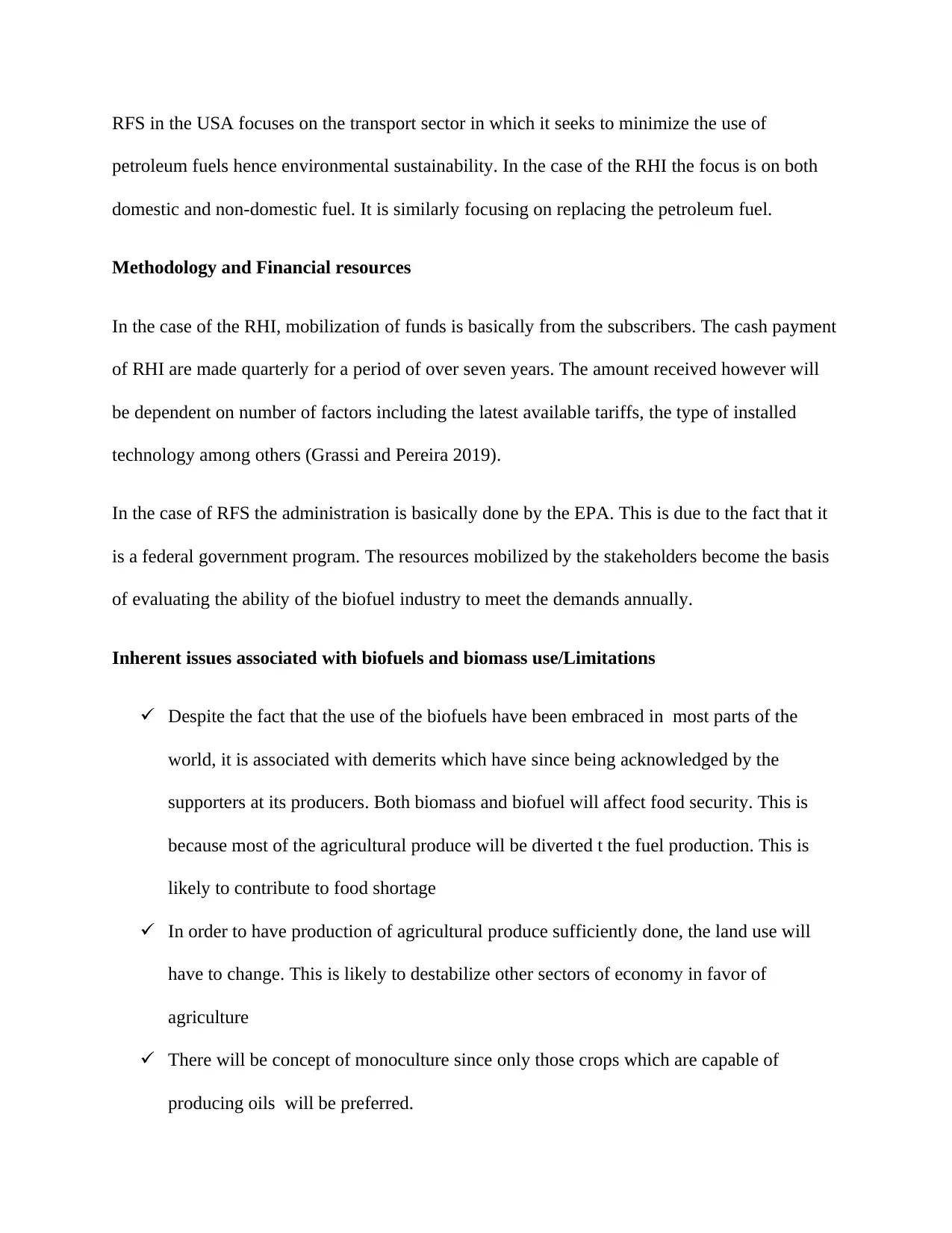
RFS in the USA focuses on the transport sector in which it seeks to minimize the use of
petroleum fuels hence environmental sustainability. In the case of the RHI the focus is on both
domestic and non-domestic fuel. It is similarly focusing on replacing the petroleum fuel.
Methodology and Financial resources
In the case of the RHI, mobilization of funds is basically from the subscribers. The cash payment
of RHI are made quarterly for a period of over seven years. The amount received however will
be dependent on number of factors including the latest available tariffs, the type of installed
technology among others (Grassi and Pereira 2019).
In the case of RFS the administration is basically done by the EPA. This is due to the fact that it
is a federal government program. The resources mobilized by the stakeholders become the basis
of evaluating the ability of the biofuel industry to meet the demands annually.
Inherent issues associated with biofuels and biomass use/Limitations
Despite the fact that the use of the biofuels have been embraced in most parts of the
world, it is associated with demerits which have since being acknowledged by the
supporters at its producers. Both biomass and biofuel will affect food security. This is
because most of the agricultural produce will be diverted t the fuel production. This is
likely to contribute to food shortage
In order to have production of agricultural produce sufficiently done, the land use will
have to change. This is likely to destabilize other sectors of economy in favor of
agriculture
There will be concept of monoculture since only those crops which are capable of
producing oils will be preferred.
petroleum fuels hence environmental sustainability. In the case of the RHI the focus is on both
domestic and non-domestic fuel. It is similarly focusing on replacing the petroleum fuel.
Methodology and Financial resources
In the case of the RHI, mobilization of funds is basically from the subscribers. The cash payment
of RHI are made quarterly for a period of over seven years. The amount received however will
be dependent on number of factors including the latest available tariffs, the type of installed
technology among others (Grassi and Pereira 2019).
In the case of RFS the administration is basically done by the EPA. This is due to the fact that it
is a federal government program. The resources mobilized by the stakeholders become the basis
of evaluating the ability of the biofuel industry to meet the demands annually.
Inherent issues associated with biofuels and biomass use/Limitations
Despite the fact that the use of the biofuels have been embraced in most parts of the
world, it is associated with demerits which have since being acknowledged by the
supporters at its producers. Both biomass and biofuel will affect food security. This is
because most of the agricultural produce will be diverted t the fuel production. This is
likely to contribute to food shortage
In order to have production of agricultural produce sufficiently done, the land use will
have to change. This is likely to destabilize other sectors of economy in favor of
agriculture
There will be concept of monoculture since only those crops which are capable of
producing oils will be preferred.
Paraphrase This Document
Need a fresh take? Get an instant paraphrase of this document with our AI Paraphraser
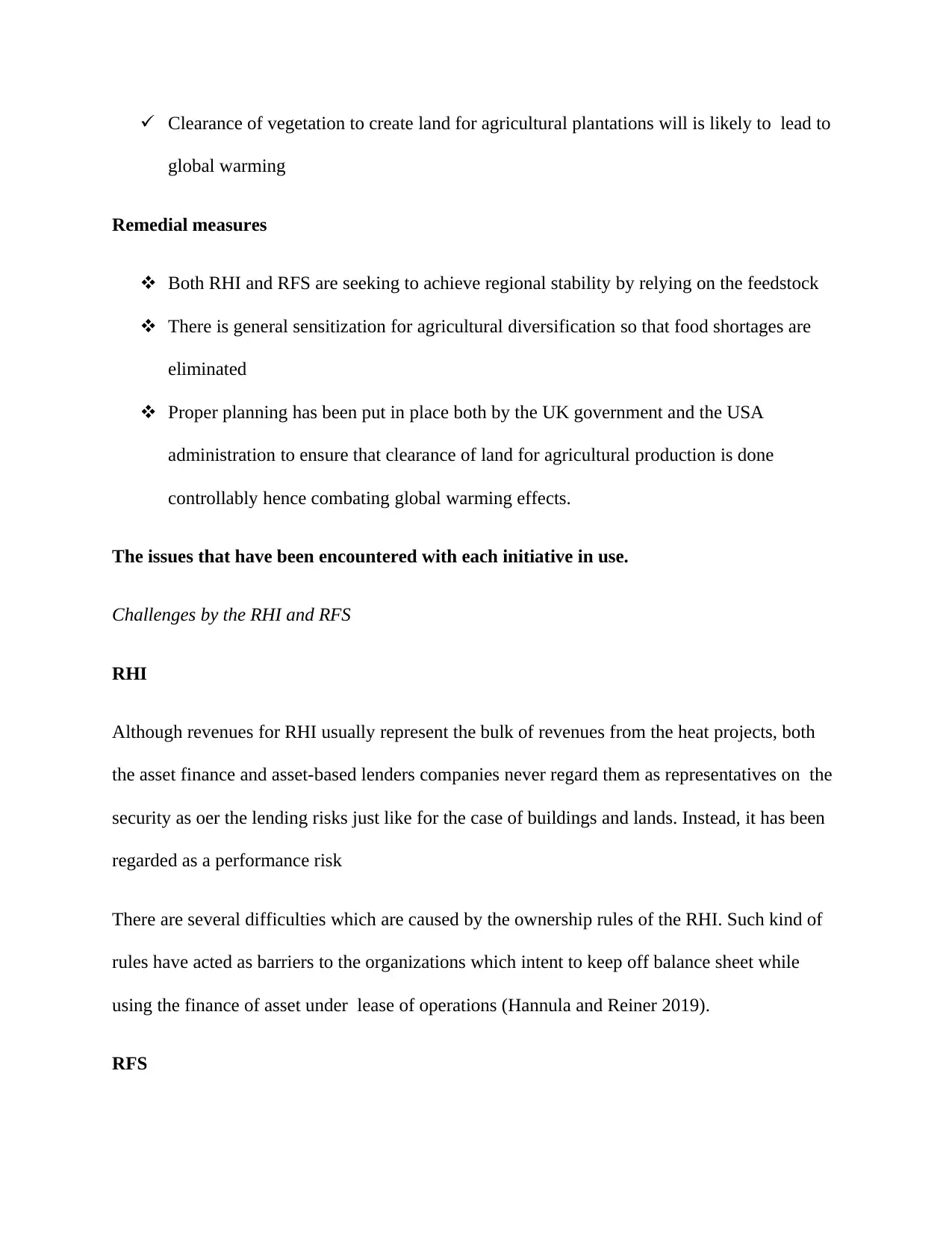
Clearance of vegetation to create land for agricultural plantations will is likely to lead to
global warming
Remedial measures
Both RHI and RFS are seeking to achieve regional stability by relying on the feedstock
There is general sensitization for agricultural diversification so that food shortages are
eliminated
Proper planning has been put in place both by the UK government and the USA
administration to ensure that clearance of land for agricultural production is done
controllably hence combating global warming effects.
The issues that have been encountered with each initiative in use.
Challenges by the RHI and RFS
RHI
Although revenues for RHI usually represent the bulk of revenues from the heat projects, both
the asset finance and asset-based lenders companies never regard them as representatives on the
security as oer the lending risks just like for the case of buildings and lands. Instead, it has been
regarded as a performance risk
There are several difficulties which are caused by the ownership rules of the RHI. Such kind of
rules have acted as barriers to the organizations which intent to keep off balance sheet while
using the finance of asset under lease of operations (Hannula and Reiner 2019).
RFS
global warming
Remedial measures
Both RHI and RFS are seeking to achieve regional stability by relying on the feedstock
There is general sensitization for agricultural diversification so that food shortages are
eliminated
Proper planning has been put in place both by the UK government and the USA
administration to ensure that clearance of land for agricultural production is done
controllably hence combating global warming effects.
The issues that have been encountered with each initiative in use.
Challenges by the RHI and RFS
RHI
Although revenues for RHI usually represent the bulk of revenues from the heat projects, both
the asset finance and asset-based lenders companies never regard them as representatives on the
security as oer the lending risks just like for the case of buildings and lands. Instead, it has been
regarded as a performance risk
There are several difficulties which are caused by the ownership rules of the RHI. Such kind of
rules have acted as barriers to the organizations which intent to keep off balance sheet while
using the finance of asset under lease of operations (Hannula and Reiner 2019).
RFS
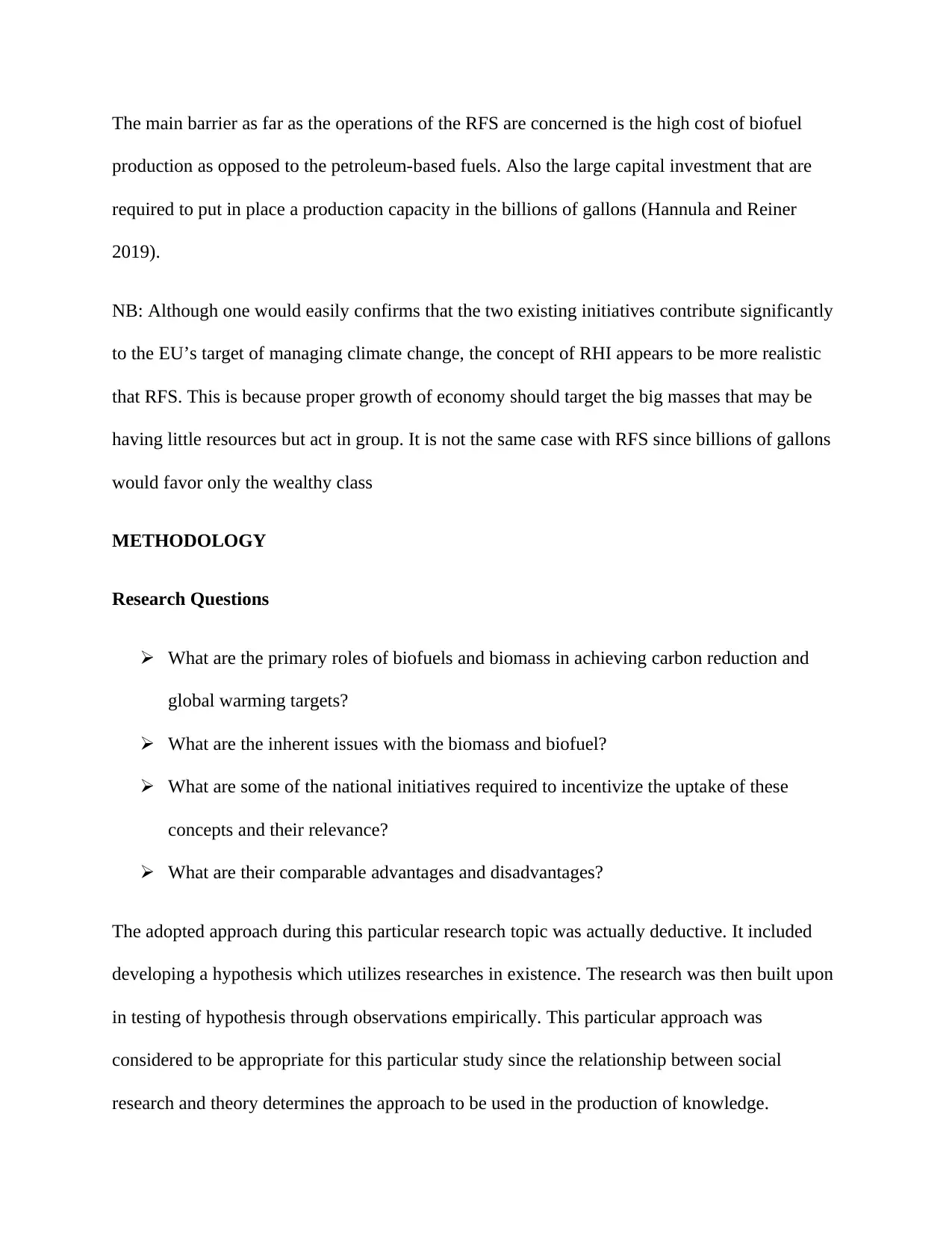
The main barrier as far as the operations of the RFS are concerned is the high cost of biofuel
production as opposed to the petroleum-based fuels. Also the large capital investment that are
required to put in place a production capacity in the billions of gallons (Hannula and Reiner
2019).
NB: Although one would easily confirms that the two existing initiatives contribute significantly
to the EU’s target of managing climate change, the concept of RHI appears to be more realistic
that RFS. This is because proper growth of economy should target the big masses that may be
having little resources but act in group. It is not the same case with RFS since billions of gallons
would favor only the wealthy class
METHODOLOGY
Research Questions
What are the primary roles of biofuels and biomass in achieving carbon reduction and
global warming targets?
What are the inherent issues with the biomass and biofuel?
What are some of the national initiatives required to incentivize the uptake of these
concepts and their relevance?
What are their comparable advantages and disadvantages?
The adopted approach during this particular research topic was actually deductive. It included
developing a hypothesis which utilizes researches in existence. The research was then built upon
in testing of hypothesis through observations empirically. This particular approach was
considered to be appropriate for this particular study since the relationship between social
research and theory determines the approach to be used in the production of knowledge.
production as opposed to the petroleum-based fuels. Also the large capital investment that are
required to put in place a production capacity in the billions of gallons (Hannula and Reiner
2019).
NB: Although one would easily confirms that the two existing initiatives contribute significantly
to the EU’s target of managing climate change, the concept of RHI appears to be more realistic
that RFS. This is because proper growth of economy should target the big masses that may be
having little resources but act in group. It is not the same case with RFS since billions of gallons
would favor only the wealthy class
METHODOLOGY
Research Questions
What are the primary roles of biofuels and biomass in achieving carbon reduction and
global warming targets?
What are the inherent issues with the biomass and biofuel?
What are some of the national initiatives required to incentivize the uptake of these
concepts and their relevance?
What are their comparable advantages and disadvantages?
The adopted approach during this particular research topic was actually deductive. It included
developing a hypothesis which utilizes researches in existence. The research was then built upon
in testing of hypothesis through observations empirically. This particular approach was
considered to be appropriate for this particular study since the relationship between social
research and theory determines the approach to be used in the production of knowledge.
⊘ This is a preview!⊘
Do you want full access?
Subscribe today to unlock all pages.

Trusted by 1+ million students worldwide
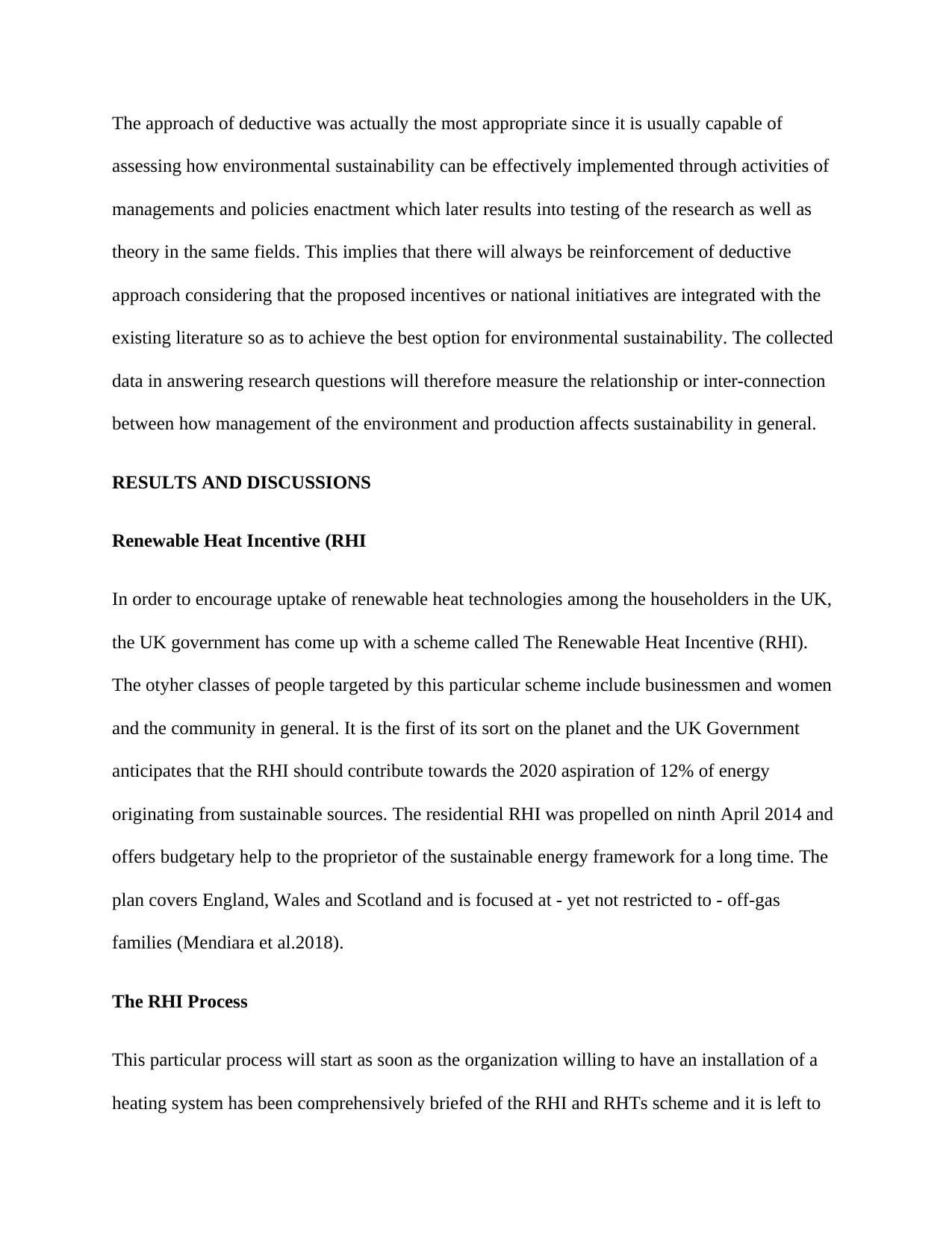
The approach of deductive was actually the most appropriate since it is usually capable of
assessing how environmental sustainability can be effectively implemented through activities of
managements and policies enactment which later results into testing of the research as well as
theory in the same fields. This implies that there will always be reinforcement of deductive
approach considering that the proposed incentives or national initiatives are integrated with the
existing literature so as to achieve the best option for environmental sustainability. The collected
data in answering research questions will therefore measure the relationship or inter-connection
between how management of the environment and production affects sustainability in general.
RESULTS AND DISCUSSIONS
Renewable Heat Incentive (RHI
In order to encourage uptake of renewable heat technologies among the householders in the UK,
the UK government has come up with a scheme called The Renewable Heat Incentive (RHI).
The otyher classes of people targeted by this particular scheme include businessmen and women
and the community in general. It is the first of its sort on the planet and the UK Government
anticipates that the RHI should contribute towards the 2020 aspiration of 12% of energy
originating from sustainable sources. The residential RHI was propelled on ninth April 2014 and
offers budgetary help to the proprietor of the sustainable energy framework for a long time. The
plan covers England, Wales and Scotland and is focused at - yet not restricted to - off-gas
families (Mendiara et al.2018).
The RHI Process
This particular process will start as soon as the organization willing to have an installation of a
heating system has been comprehensively briefed of the RHI and RHTs scheme and it is left to
assessing how environmental sustainability can be effectively implemented through activities of
managements and policies enactment which later results into testing of the research as well as
theory in the same fields. This implies that there will always be reinforcement of deductive
approach considering that the proposed incentives or national initiatives are integrated with the
existing literature so as to achieve the best option for environmental sustainability. The collected
data in answering research questions will therefore measure the relationship or inter-connection
between how management of the environment and production affects sustainability in general.
RESULTS AND DISCUSSIONS
Renewable Heat Incentive (RHI
In order to encourage uptake of renewable heat technologies among the householders in the UK,
the UK government has come up with a scheme called The Renewable Heat Incentive (RHI).
The otyher classes of people targeted by this particular scheme include businessmen and women
and the community in general. It is the first of its sort on the planet and the UK Government
anticipates that the RHI should contribute towards the 2020 aspiration of 12% of energy
originating from sustainable sources. The residential RHI was propelled on ninth April 2014 and
offers budgetary help to the proprietor of the sustainable energy framework for a long time. The
plan covers England, Wales and Scotland and is focused at - yet not restricted to - off-gas
families (Mendiara et al.2018).
The RHI Process
This particular process will start as soon as the organization willing to have an installation of a
heating system has been comprehensively briefed of the RHI and RHTs scheme and it is left to
Paraphrase This Document
Need a fresh take? Get an instant paraphrase of this document with our AI Paraphraser
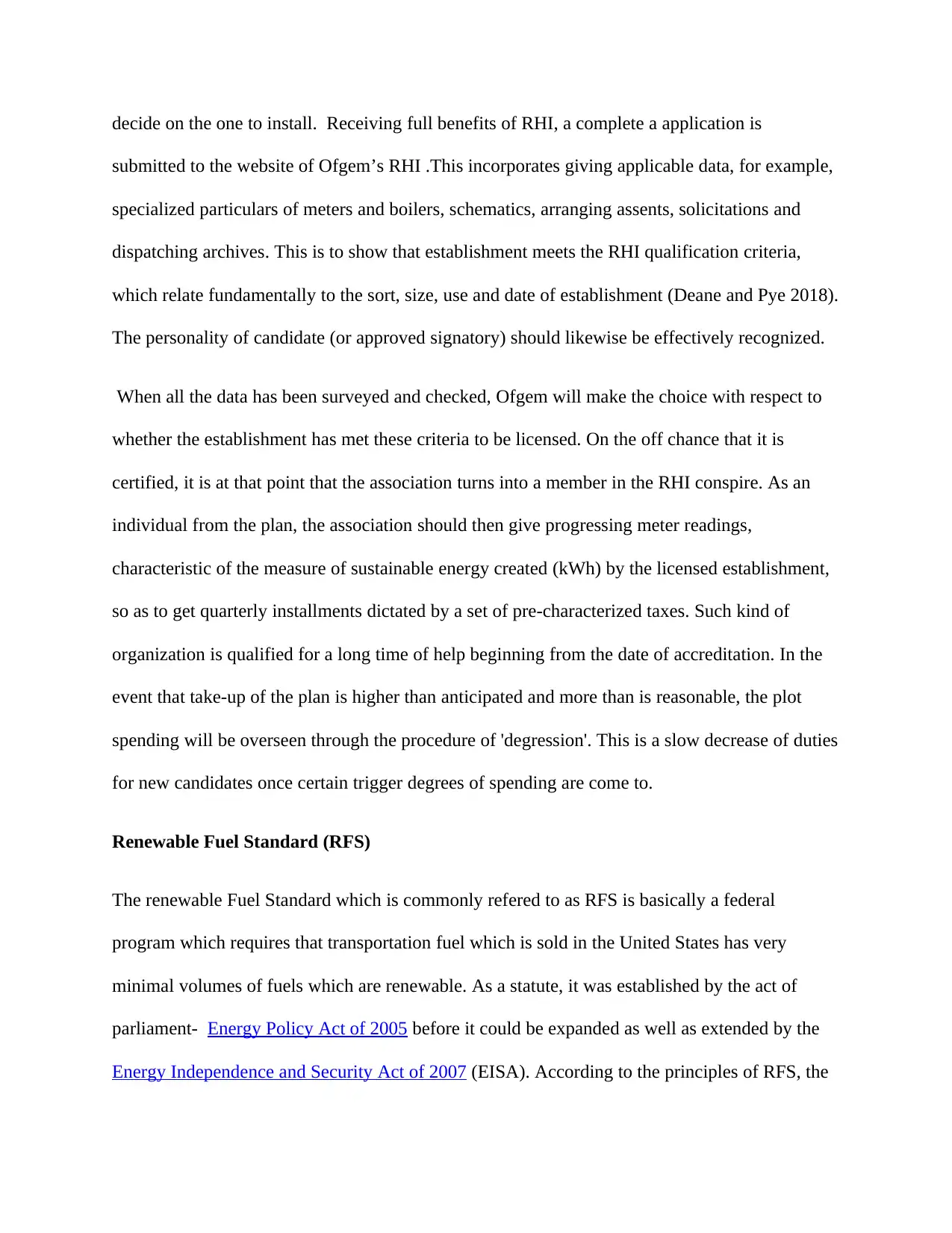
decide on the one to install. Receiving full benefits of RHI, a complete a application is
submitted to the website of Ofgem’s RHI .This incorporates giving applicable data, for example,
specialized particulars of meters and boilers, schematics, arranging assents, solicitations and
dispatching archives. This is to show that establishment meets the RHI qualification criteria,
which relate fundamentally to the sort, size, use and date of establishment (Deane and Pye 2018).
The personality of candidate (or approved signatory) should likewise be effectively recognized.
When all the data has been surveyed and checked, Ofgem will make the choice with respect to
whether the establishment has met these criteria to be licensed. On the off chance that it is
certified, it is at that point that the association turns into a member in the RHI conspire. As an
individual from the plan, the association should then give progressing meter readings,
characteristic of the measure of sustainable energy created (kWh) by the licensed establishment,
so as to get quarterly installments dictated by a set of pre-characterized taxes. Such kind of
organization is qualified for a long time of help beginning from the date of accreditation. In the
event that take-up of the plan is higher than anticipated and more than is reasonable, the plot
spending will be overseen through the procedure of 'degression'. This is a slow decrease of duties
for new candidates once certain trigger degrees of spending are come to.
Renewable Fuel Standard (RFS)
The renewable Fuel Standard which is commonly refered to as RFS is basically a federal
program which requires that transportation fuel which is sold in the United States has very
minimal volumes of fuels which are renewable. As a statute, it was established by the act of
parliament- Energy Policy Act of 2005 before it could be expanded as well as extended by the
Energy Independence and Security Act of 2007 (EISA). According to the principles of RFS, the
submitted to the website of Ofgem’s RHI .This incorporates giving applicable data, for example,
specialized particulars of meters and boilers, schematics, arranging assents, solicitations and
dispatching archives. This is to show that establishment meets the RHI qualification criteria,
which relate fundamentally to the sort, size, use and date of establishment (Deane and Pye 2018).
The personality of candidate (or approved signatory) should likewise be effectively recognized.
When all the data has been surveyed and checked, Ofgem will make the choice with respect to
whether the establishment has met these criteria to be licensed. On the off chance that it is
certified, it is at that point that the association turns into a member in the RHI conspire. As an
individual from the plan, the association should then give progressing meter readings,
characteristic of the measure of sustainable energy created (kWh) by the licensed establishment,
so as to get quarterly installments dictated by a set of pre-characterized taxes. Such kind of
organization is qualified for a long time of help beginning from the date of accreditation. In the
event that take-up of the plan is higher than anticipated and more than is reasonable, the plot
spending will be overseen through the procedure of 'degression'. This is a slow decrease of duties
for new candidates once certain trigger degrees of spending are come to.
Renewable Fuel Standard (RFS)
The renewable Fuel Standard which is commonly refered to as RFS is basically a federal
program which requires that transportation fuel which is sold in the United States has very
minimal volumes of fuels which are renewable. As a statute, it was established by the act of
parliament- Energy Policy Act of 2005 before it could be expanded as well as extended by the
Energy Independence and Security Act of 2007 (EISA). According to the principles of RFS, the
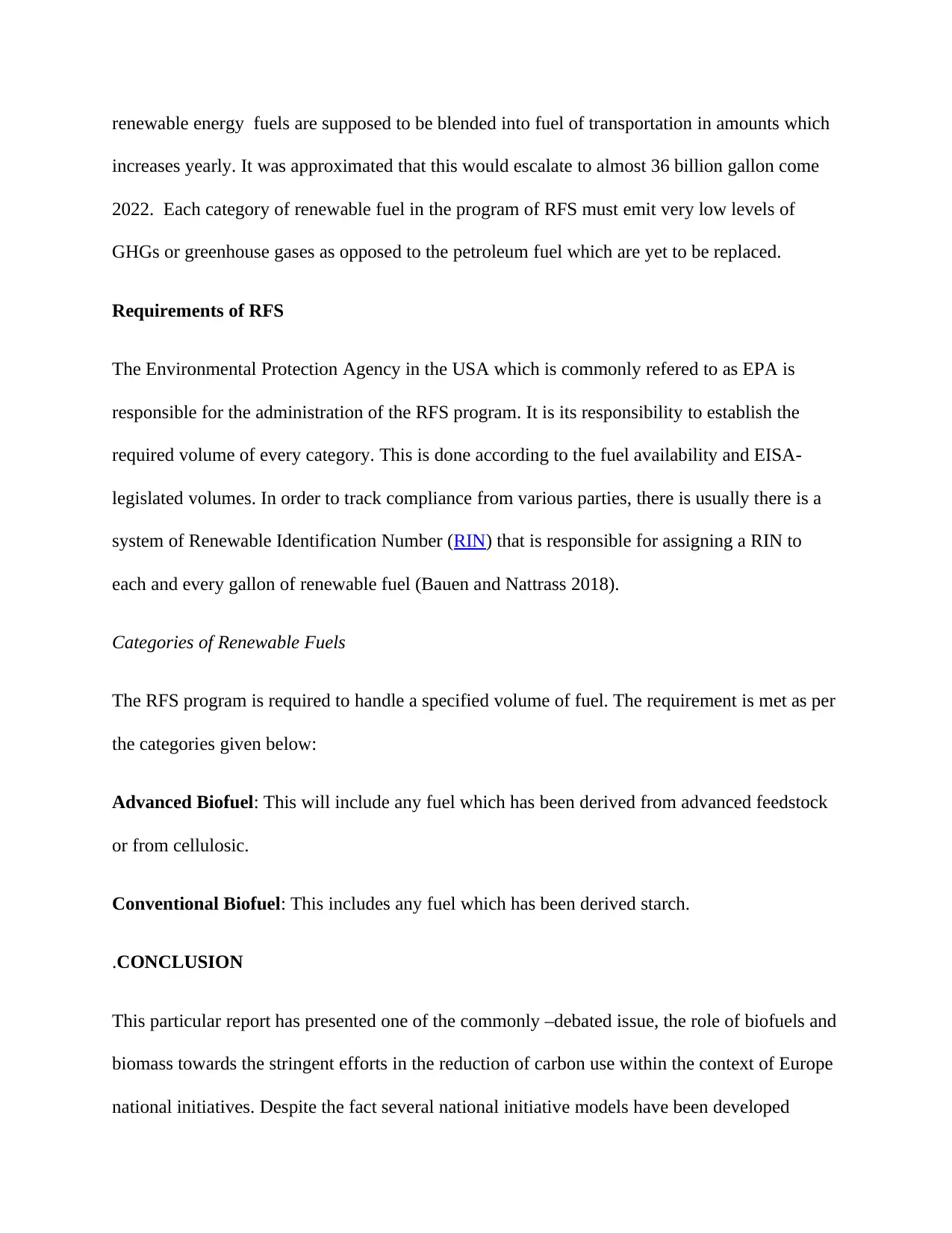
renewable energy fuels are supposed to be blended into fuel of transportation in amounts which
increases yearly. It was approximated that this would escalate to almost 36 billion gallon come
2022. Each category of renewable fuel in the program of RFS must emit very low levels of
GHGs or greenhouse gases as opposed to the petroleum fuel which are yet to be replaced.
Requirements of RFS
The Environmental Protection Agency in the USA which is commonly refered to as EPA is
responsible for the administration of the RFS program. It is its responsibility to establish the
required volume of every category. This is done according to the fuel availability and EISA-
legislated volumes. In order to track compliance from various parties, there is usually there is a
system of Renewable Identification Number (RIN) that is responsible for assigning a RIN to
each and every gallon of renewable fuel (Bauen and Nattrass 2018).
Categories of Renewable Fuels
The RFS program is required to handle a specified volume of fuel. The requirement is met as per
the categories given below:
Advanced Biofuel: This will include any fuel which has been derived from advanced feedstock
or from cellulosic.
Conventional Biofuel: This includes any fuel which has been derived starch.
.CONCLUSION
This particular report has presented one of the commonly –debated issue, the role of biofuels and
biomass towards the stringent efforts in the reduction of carbon use within the context of Europe
national initiatives. Despite the fact several national initiative models have been developed
increases yearly. It was approximated that this would escalate to almost 36 billion gallon come
2022. Each category of renewable fuel in the program of RFS must emit very low levels of
GHGs or greenhouse gases as opposed to the petroleum fuel which are yet to be replaced.
Requirements of RFS
The Environmental Protection Agency in the USA which is commonly refered to as EPA is
responsible for the administration of the RFS program. It is its responsibility to establish the
required volume of every category. This is done according to the fuel availability and EISA-
legislated volumes. In order to track compliance from various parties, there is usually there is a
system of Renewable Identification Number (RIN) that is responsible for assigning a RIN to
each and every gallon of renewable fuel (Bauen and Nattrass 2018).
Categories of Renewable Fuels
The RFS program is required to handle a specified volume of fuel. The requirement is met as per
the categories given below:
Advanced Biofuel: This will include any fuel which has been derived from advanced feedstock
or from cellulosic.
Conventional Biofuel: This includes any fuel which has been derived starch.
.CONCLUSION
This particular report has presented one of the commonly –debated issue, the role of biofuels and
biomass towards the stringent efforts in the reduction of carbon use within the context of Europe
national initiatives. Despite the fact several national initiative models have been developed
⊘ This is a preview!⊘
Do you want full access?
Subscribe today to unlock all pages.

Trusted by 1+ million students worldwide
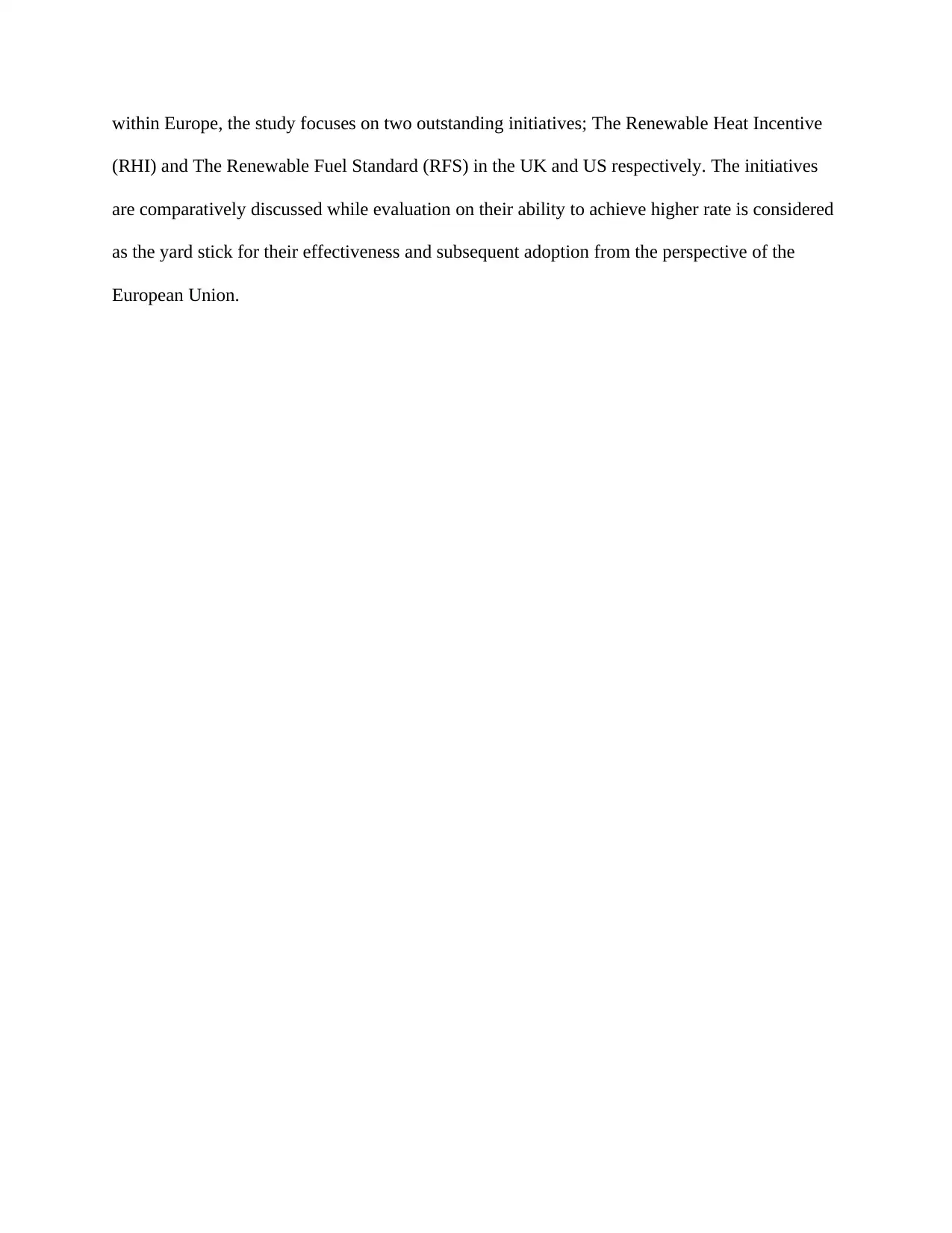
within Europe, the study focuses on two outstanding initiatives; The Renewable Heat Incentive
(RHI) and The Renewable Fuel Standard (RFS) in the UK and US respectively. The initiatives
are comparatively discussed while evaluation on their ability to achieve higher rate is considered
as the yard stick for their effectiveness and subsequent adoption from the perspective of the
European Union.
(RHI) and The Renewable Fuel Standard (RFS) in the UK and US respectively. The initiatives
are comparatively discussed while evaluation on their ability to achieve higher rate is considered
as the yard stick for their effectiveness and subsequent adoption from the perspective of the
European Union.
Paraphrase This Document
Need a fresh take? Get an instant paraphrase of this document with our AI Paraphraser
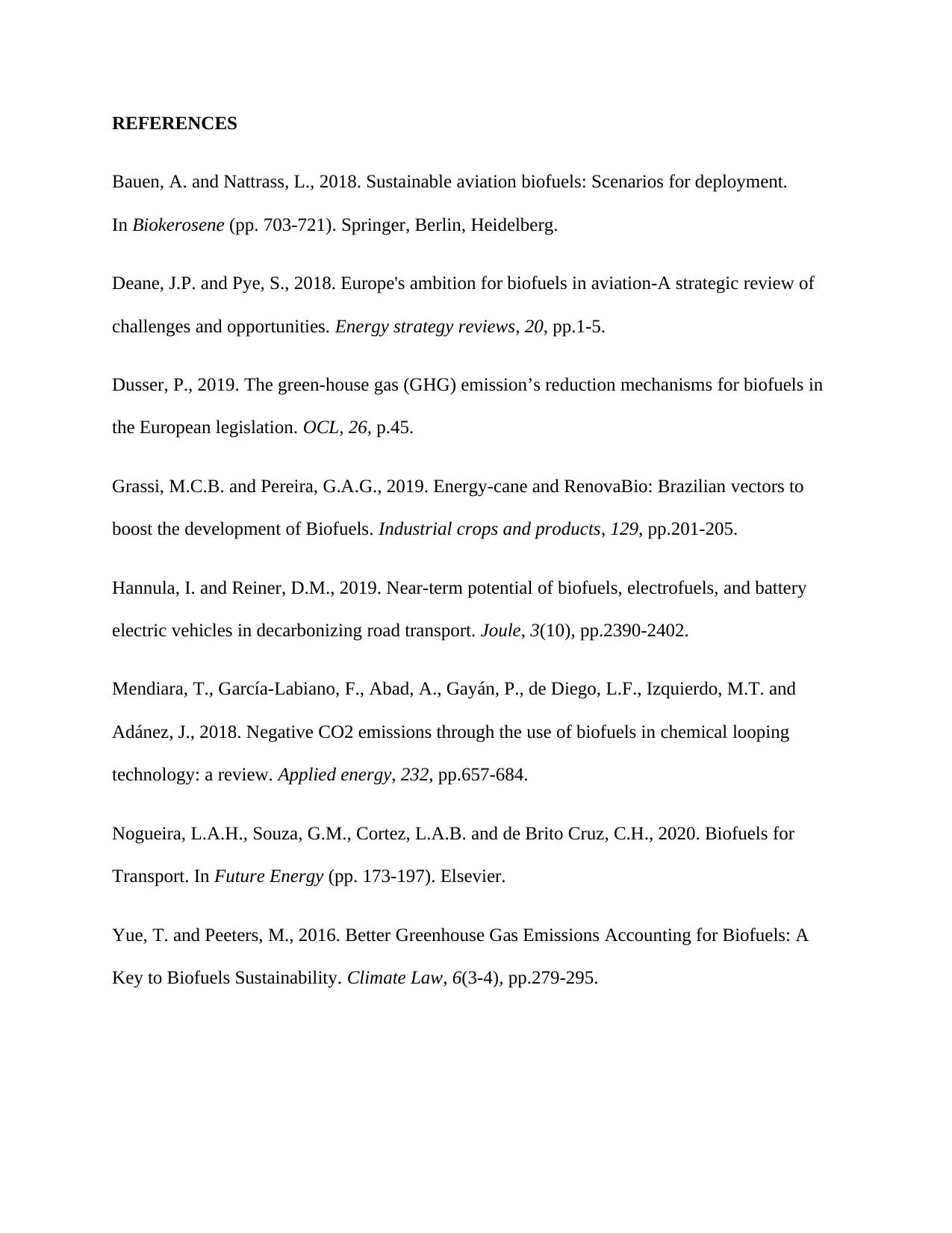
REFERENCES
Bauen, A. and Nattrass, L., 2018. Sustainable aviation biofuels: Scenarios for deployment.
In Biokerosene (pp. 703-721). Springer, Berlin, Heidelberg.
Deane, J.P. and Pye, S., 2018. Europe's ambition for biofuels in aviation-A strategic review of
challenges and opportunities. Energy strategy reviews, 20, pp.1-5.
Dusser, P., 2019. The green-house gas (GHG) emission’s reduction mechanisms for biofuels in
the European legislation. OCL, 26, p.45.
Grassi, M.C.B. and Pereira, G.A.G., 2019. Energy-cane and RenovaBio: Brazilian vectors to
boost the development of Biofuels. Industrial crops and products, 129, pp.201-205.
Hannula, I. and Reiner, D.M., 2019. Near-term potential of biofuels, electrofuels, and battery
electric vehicles in decarbonizing road transport. Joule, 3(10), pp.2390-2402.
Mendiara, T., García-Labiano, F., Abad, A., Gayán, P., de Diego, L.F., Izquierdo, M.T. and
Adánez, J., 2018. Negative CO2 emissions through the use of biofuels in chemical looping
technology: a review. Applied energy, 232, pp.657-684.
Nogueira, L.A.H., Souza, G.M., Cortez, L.A.B. and de Brito Cruz, C.H., 2020. Biofuels for
Transport. In Future Energy (pp. 173-197). Elsevier.
Yue, T. and Peeters, M., 2016. Better Greenhouse Gas Emissions Accounting for Biofuels: A
Key to Biofuels Sustainability. Climate Law, 6(3-4), pp.279-295.
Bauen, A. and Nattrass, L., 2018. Sustainable aviation biofuels: Scenarios for deployment.
In Biokerosene (pp. 703-721). Springer, Berlin, Heidelberg.
Deane, J.P. and Pye, S., 2018. Europe's ambition for biofuels in aviation-A strategic review of
challenges and opportunities. Energy strategy reviews, 20, pp.1-5.
Dusser, P., 2019. The green-house gas (GHG) emission’s reduction mechanisms for biofuels in
the European legislation. OCL, 26, p.45.
Grassi, M.C.B. and Pereira, G.A.G., 2019. Energy-cane and RenovaBio: Brazilian vectors to
boost the development of Biofuels. Industrial crops and products, 129, pp.201-205.
Hannula, I. and Reiner, D.M., 2019. Near-term potential of biofuels, electrofuels, and battery
electric vehicles in decarbonizing road transport. Joule, 3(10), pp.2390-2402.
Mendiara, T., García-Labiano, F., Abad, A., Gayán, P., de Diego, L.F., Izquierdo, M.T. and
Adánez, J., 2018. Negative CO2 emissions through the use of biofuels in chemical looping
technology: a review. Applied energy, 232, pp.657-684.
Nogueira, L.A.H., Souza, G.M., Cortez, L.A.B. and de Brito Cruz, C.H., 2020. Biofuels for
Transport. In Future Energy (pp. 173-197). Elsevier.
Yue, T. and Peeters, M., 2016. Better Greenhouse Gas Emissions Accounting for Biofuels: A
Key to Biofuels Sustainability. Climate Law, 6(3-4), pp.279-295.
1 out of 11
Related Documents
Your All-in-One AI-Powered Toolkit for Academic Success.
+13062052269
info@desklib.com
Available 24*7 on WhatsApp / Email
![[object Object]](/_next/static/media/star-bottom.7253800d.svg)
Unlock your academic potential
Copyright © 2020–2025 A2Z Services. All Rights Reserved. Developed and managed by ZUCOL.



